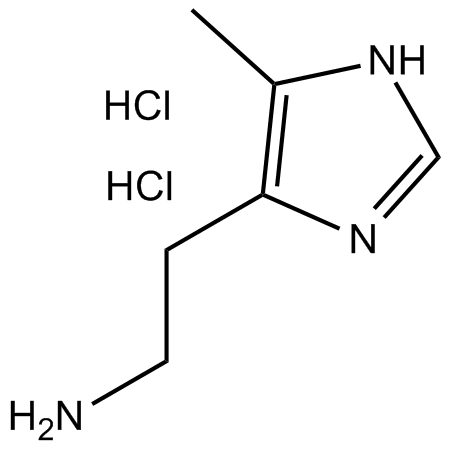4-Methylhistamine dihydrochloride |
| Catalog No.GC12737 |
H4 receptor agonist
Products are for research use only. Not for human use. We do not sell to patients.

Cas No.: 36376-47-3
Sample solution is provided at 25 µL, 10mM.
4-Methylhistamine dihydrochloride (or 4-methylhistamine) is a selective agonist of H4 receptor with a pEC50 value of 7.4±0.1 (α=1) [1].
In the chemotaxis of mast cells and leukocytes to sites of inflammation, the histamine H4 receptor (H4R) is involved [1].
In transfected cells, 4-methylhistamine bound to hH4R with the highest affinity, compared to the binding to other histamine receptors. The interaction between 4-methylhistamine and hH4R showed a higher selectivity than that between the drug and the H3R and H2R, and H1R by >100-fold and >100,000-fold, respectively. 4-Methylhistamine also had a high affinity for the rat and mouse H4R with Ki values of 73 and 55 nM, respectively, though this affinity was lower than that for hH4R. The agonistic effects of 4-methylhistamine to hH4R were antagonized by JNJ 7777120, a selective H4R antagonist. To the rat and mouse H4R, as a full H4 agonist, 4-methylhistamine showed pEC50 values of 5.6 ± 0.1 and 5.8 ± 0.1, respectively [1].
After being fasted for 18 h, rats were administered intraperitoneally (i.p.) with a single dose of 4-methylhistamine. 2 h later, they were subjected to a intra-articular (i.a.) injection of LPS. In both groups treated with 4-methylhistamine and LPS alone, respectively, the expression of TNF-α and NF-κB was increased, levels of IkB-α were decreased in synovial fluid and whole blood. Further, mRNA levels of IL-1β, TNF-α, and NF-κB were significantly increased. Western blot analysis results also confirmed that the expression of TNF-α, JAK-1, NF-κB and STAT-3 was increased in both 4-methylhistamine and LPS treatment groups. In the inflamed knee tissue of the JNJ 7777120-treated group, these increases were completely inhibited [2].
References:
[1]. Lim HD, van Rijn RM, Ling P, et al. Evaluation of histamine H1-, H2-, and H3-receptor ligands at the human histamine H4 receptor: identification of 4-methylhistamine as the first potent and selective H4 receptor agonist. Journal of Pharmacology and Experimental Therapeutics, 2005, 314(3): 1310-1321.
[2]. Ahmad SF, Ansari MA, Zoheir KMA, et al. Regulation of TNF-α and NF-κB activation through the JAK/STAT signaling pathway downstream of histamine 4 receptor in a rat model of LPS-induced joint inflammation. Immunobiology, 2015, 220(7): 889-898.
Average Rating: 5 (Based on Reviews and 35 reference(s) in Google Scholar.)
GLPBIO products are for RESEARCH USE ONLY. Please make sure your review or question is research based.
Required fields are marked with *




















